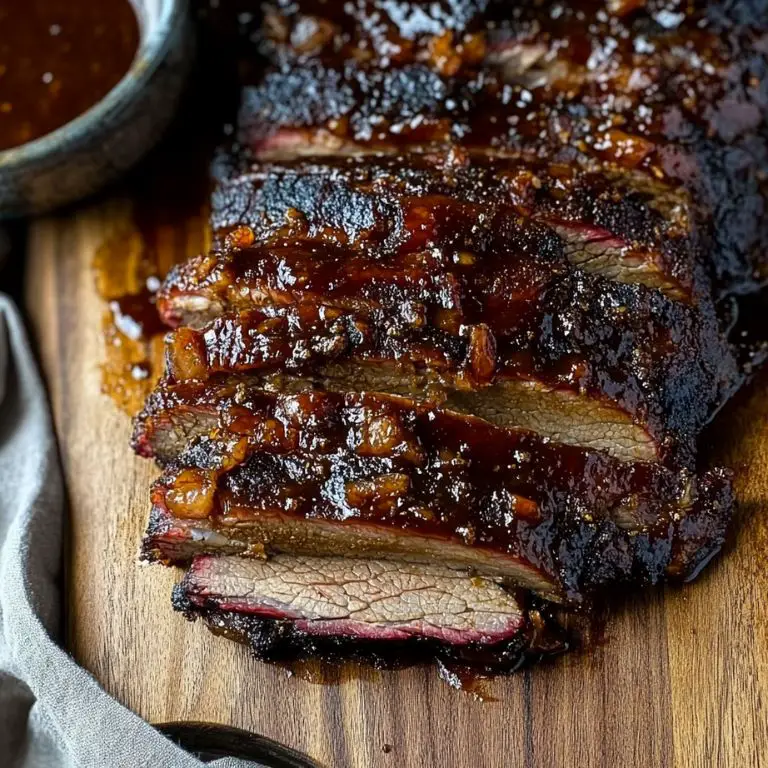
There’s nothing quite like a beautifully smoked brisket, but what if you don’t have a smoker? No worries—this oven-baked BBQ beef brisket gives you that slow-cooked, melt-in-your-mouth texture with a deep smoky flavor, all from the comfort of your kitchen. With a flavorful dry rub, a slow-roasting method, and a tangy BBQ glaze, this brisket is guaranteed to be the star of any gathering.
Brisket comes from a hardworking muscle group in the cow, meaning it’s naturally tough with a lot of connective tissue. Low-and-slow cooking is the key to transforming this tough cut into a tender, melt-in-your-mouth masterpiece. At a low temperature like 275°F, collagen in the meat breaks down slowly into gelatin, keeping the brisket moist and juicy instead of dry and chewy. Rushing the process at a higher temperature risks tough, dry meat. Patience pays off, as the gradual breakdown of connective fibers creates the signature tender texture that BBQ brisket is famous for.
If you don't have a large roasting pan, don't worry—there are great alternatives for oven-baking brisket. A Dutch oven is perfect for locking in moisture while maintaining even heat. Place your brisket in a large Dutch oven, cover it tightly with the lid, and follow the same low-and-slow baking method. Another great option is using a roasting bag. Roasting bags trap steam, making the brisket incredibly tender and reducing the risk of drying out. Simply season your brisket, place it in the bag with the broth and vinegar, and bake according to the recipe instructions. Both methods can enhance tenderness while slightly reducing cooking time.
Slicing brisket correctly is just as important as cooking it well. Always slice against the grain—this means cutting across the muscle fibers, not alongside them. Slicing with the grain would leave you with long, tough strands of meat that are hard to chew. A sharp slicing knife or a long carving knife works best. Aim for slices that are about ¼ inch thick: thick enough to stay juicy but thin enough to be tender. If your brisket includes both the flat and point cuts, remember the grain changes direction slightly between them, so adjust your slicing angle accordingly.
While a classic smoky-sweet BBQ sauce is a favorite, pairing brisket with different regional sauces can dramatically change its flavor profile.
One of the best things about making brisket is the leftovers—just as flavorful the next day and incredibly versatile. Shred leftover brisket and pile it onto soft rolls with coleslaw for irresistible sliders. Or repurpose it into brisket tacos, quesadillas, or burrito bowls with rice, beans, and avocado. It’s also perfect for a Texas-style brisket chili or as a savory topping for baked potatoes or loaded nachos. For a brunch twist, stir chopped brisket into scrambled eggs or layer it into a breakfast hash. With a little creativity, your brisket can easily become the foundation of multiple meals throughout the week.
Brisket can be easily adapted for low-carb or gluten-free diets. Skip sugary sauces and use a no-sugar-added BBQ sauce or make your own with keto-friendly sweeteners like monk fruit. Serve with cauliflower mash, roasted veggies, or a side salad instead of traditional starches. Just be sure to check your broth, rub ingredients, and BBQ sauce for any hidden gluten or additives. With simple adjustments, this dish can be both indulgent and diet-conscious, satisfying a wide range of guests.
Brisket stores and freezes beautifully, making it a great option for meal prepping or saving leftovers. To store, wrap slices tightly in foil or place them in an airtight container with some of the cooking juices to keep the meat moist. Refrigerate for up to 4 days. To freeze, wrap portions in foil, then place them in a freezer bag, squeezing out as much air as possible. Brisket can be frozen for up to 3 months. To reheat, thaw in the fridge overnight, then warm gently in a 275°F oven, covered with foil and a splash of broth to help retain moisture.
These small but impactful techniques will make the difference between a good brisket and a truly unforgettable one!
A flat cut is leaner and easier to slice, while a packer cut (includes both the flat and point) has more fat for extra juiciness. Both work well in the oven, but a packer cut gives the best flavor.
Yes! Brisket actually tastes better the next day. Wrap it in foil and reheat in a low oven (275°F) until warm.
Use smoked paprika in the rub and consider adding a drop of liquid smoke to your broth mixture for an extra smoky kick.